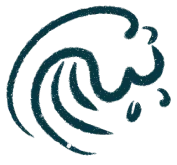How to Nail Your LinkedIn Cold Outreach Strategy
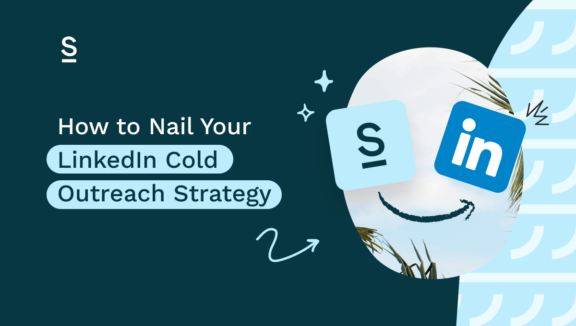
The printer jamming 5 minutes before a client meeting.
Trying to figure out who took AE Dave’s clearly labeled leftover lasagna out of the office fridge.
Speed-walking to a meeting room, knowing your colleague intends to hold a separate call there too.
All pretty high-stakes situations, right? Right – but fortunately, as a sales professional, you’re used to high stakes.
Take your LinkedIn cold outreach strategy, for example. Do it right, and you’ll turn cold leads into conversations that end up making your business – and, ahem, you – a lot of money. Do it wrong, and you’ll be ignored, or worse, blacklisted as a spammer.
Today, we’re going to teach you how to get your LinkedIn cold outreach strategy just right, by breaking down tactics proven to get results. Here’s what we’re going to cover:
- The Reality of Cold Outreach – By the Numbers
- The Perfect LinkedIn Cold Outreach Strategy Step-by-Step
- Why Surfe is a Must-Have for Cold Outreach
By the time you’ve finished reading, you’ll be able to build and execute a LinkedIn cold outreach strategy that gets higher response rates, more booked meetings, and better conversions.
After all that, you might even be able to treat yourself to lunch instead of stealing Dave’s. Don’t worry – we won’t tell anyone. Let’s get started.
The Reality of Cold Outreach – By the Numbers
First things first, why is your LinkedIn cold outreach strategy so important?
Two reasons:
- Everyone in B2B is on LinkedIn these days. Yes, really – it’s got over 1 billion users.
- You should always reach out to prospects via multiple channels as part of a multi-touch, multi-channel strategy. And LinkedIn should definitely be one of them.
If you’re wondering why we have to bother with a multi-touch, multi-channel strategy, we’ll tell you. The average open rate of cold emails is 23.9%. As for replies? You’re looking at 1-10%, depending on who you ask.
Now, that doesn’t mean you should never go near email ever again – far from it – but it does mean that you need to combine email with another channel. The average reply rate on LinkedIn is 5-20% – and that goes up to 25% for LinkedIn InMail. Use a LinkedIn cold outreach strategy alongside cold email (and other channels like cold calling, too) and you’ll be on the money.
Want to get even better results? Personalize your messages. Send a single personalized message on LinkedIn, and you could boost your response rate by 30%. Not to be sniffed at.
So, we now know that LinkedIn cold outreach is an important component of any outreach strategy and that you should personalize your messages for the very best results. Next up: how to actually do it.
The Perfect LinkedIn Cold Outreach Strategy Step-by-Step
Because we’re lovely people, we’re going to walk you through a flawless (if we do say so ourselves) LinkedIn cold outreach strategy, step-by-step. Without further ado:
Step 1: Research & Personalization
Sending the same message to 100 people is a no-go: we’ve already covered that.
Use insights from their LinkedIn profile – job changes, recent posts, shared connections – to figure out how to personalize your outreach. If that sounds like a bit of a hassle, don’t worry. You can make it super easy by using a little tool called Surfe (hey!).
Surfe keeps track of things like job changes and sends you a notification when something interesting happens. To carry on with this example, say a prospect has recently moved companies. You could start off your LinkedIn cold outreach strategy with a congratulations message – this is doubly smart as execs often review a tech stack and make changes when they start a new role.
The beauty of using Surfe to help you is that you don’t have to manually keep track of what every single person on your prospect list is doing – instead, you can rely on Surfe notifications to tell you when to take action, and focus on the important stuff in the meantime.
Step 2: Crafting the First Message
Now, time to craft your first message. A good rule of thumb is to keep it short, personalized, and value-driven.
Avoid generic sales pitches or your life story. Instead, make it abundantly clear what they’ll get out of replying to you – and show you’ve done your homework too to build trust.
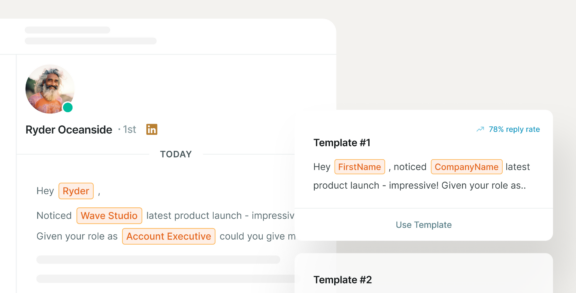
Step 3: The Follow-Up Plan
On LinkedIn, you generally only need 3-4 follow-ups to get a response. That’s pretty good going – but follow-ups can still take up a lot of time and energy when you’re working at scale.
That’s exactly where Surfe can come in to save the day – again! – with its automated follow-ups feature. It’s easy to set up a set process for following up – and when you’re not spending your precious time worrying about who you need to follow up with, when, and what you’re going to say, you can focus on more strategic activities that take up more brain power. Clever!
Just in case you weren’t reading the above carefully enough – remember to mix up the channels you use. Your approach should be a combination of LinkedIn messages, emails, and calls. Meet your prospects everywhere they’re at, and you’re far more likely to generate a response.
Step 4: Timing & Frequency
Next up – timing and frequency. Exactly when and how often you send out your messages will depend on your unique business – it’s an important part of your LinkedIn cold outreach strategy, and you should be testing, testing, testing until you figure out what gets you the best response rates.
Generally speaking, though, you want a cold outreach sequence to take somewhere between 2-3 weeks, and leave plenty of space in between each attempt. The goal is to be cheerfully persistent, not pushy. Chase too regularly or too often, and you risk annoying your prospects. And, spoiler alert, nobody wants to buy from someone they find annoying.
Why Surfe is a Must-Have for Cold Outreach
You might have spotted that we’ve mentioned Surfe a couple of times in this blog post. No, we’re not just showing off – ok, maybe we are a little bit – but we do genuinely think Surfe is a killer addition to any self-respecting LinkedIn cold outreach strategy.
Here’s why:
- It gives you instant access to accurate contact details, like emails (using our free email finder), phone numbers, and LinkedIn profiles
- Once you’ve found contact details you like the look of, it’ll transfer them over to your CRM in just one click. Seeya later, manual data entry!
- It also helps you track conversations across channels, so you can stay organized and follow-up effectively. No more missed responses or accidental double-messages.
- By automating the admin stuff like follow-ups, you’ll be able to scale your outreach efforts without losing the personal touch. More messages sent + personalization every time = more responses. Simple.
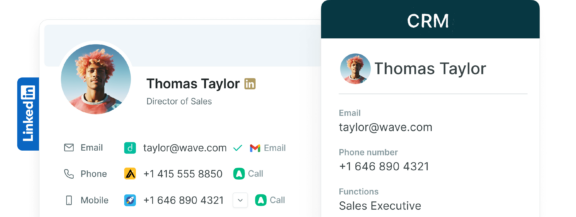
Let’s Wrap It Up!
Get your LinkedIn cold outreach strategy right, and you’ll never have to resort to stealing Dave’s lasagne again (even if it does look really, really delicious).
Don’t skimp on the personalization, get the follow-ups right, and experiment with timing, and you’ll be well on your way to a prospecting process that really delivers. PS: use Surfe to help you, and you’ll get there a lot, lot faster. Sounds like a good plan to us.
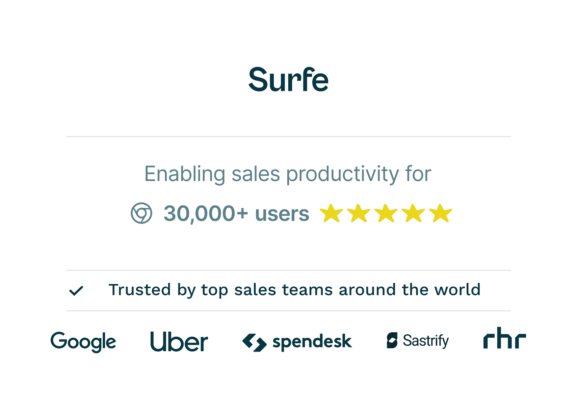
Never steal someone’s lunch again.
Use Surfe, and you’ll be responsible for more conversions than you can shake a stick at – lunch is on you, then!
LinkedIn Cold Outreach Strategy FAQs
How Can I Improve My LinkedIn Cold Outreach Strategy?
The key to a successful LinkedIn cold outreach strategy is personalization. Avoid mass messaging and instead tailor each message to the recipient by referencing job changes, recent posts, or mutual connections. Keep messages short, value-driven, and focused on how you can help them. Follow up 3-4 times to increase your chances of getting a response. Using tools like Surfe can streamline this process by automating follow-ups and tracking conversations, so you can focus on building relationships rather than manual admin work.
What Is the Best Way to Start a LinkedIn Cold Outreach Message?
Start with a personalized opener – mention a shared connection, a recent post they shared, or a company update. Keep your message short (2-3 sentences), and avoid generic sales pitches. Instead, focus on providing immediate value by explaining why you’re reaching out and what’s in it for them. A great approach is to offer relevant insights or solutions that align with their business goals.
How Many Follow-Ups Should I Send for LinkedIn Cold Outreach?
A good rule of thumb is to send 3-4 follow-ups, as part of a wider multi-touch, multi-channel outreach strategy. The key is to be persistent without being pushy. Each follow-up should add value – whether that’s a new insight, a resource, or a different angle on your original message. Using a tool like Surfe can automate follow-ups, ensuring you stay on top of cold outreach without spending hours on manual tracking.
Should I Use Automation for LinkedIn Cold Outreach?
Yes, as long as you’re careful. Automation can be incredibly useful for organizing follow-ups and tracking engagement, but your outreach should still feel personal. The best approach is to automate repetitive tasks – like reminders and follow-ups – while keeping the actual messages tailored to the recipient. Tools like Surfe strike the perfect balance by handling the admin side of outreach while allowing you to focus on meaningful, personalized conversations.
Why Is Personalization Important in LinkedIn Cold Outreach?
Personalization increases response rates by showing prospects that you’ve taken the time to understand them. A generic pitch feels spammy, whereas a message that references a job change, a mutual connection, or a specific challenge they face is far more likely to get a reply. Research shows that personalized LinkedIn messages can boost response rates by 30%. Using tools like Surfe can make personalization easier by notifying you of key prospect updates, so you can reach out at the right time with relevant messaging.

